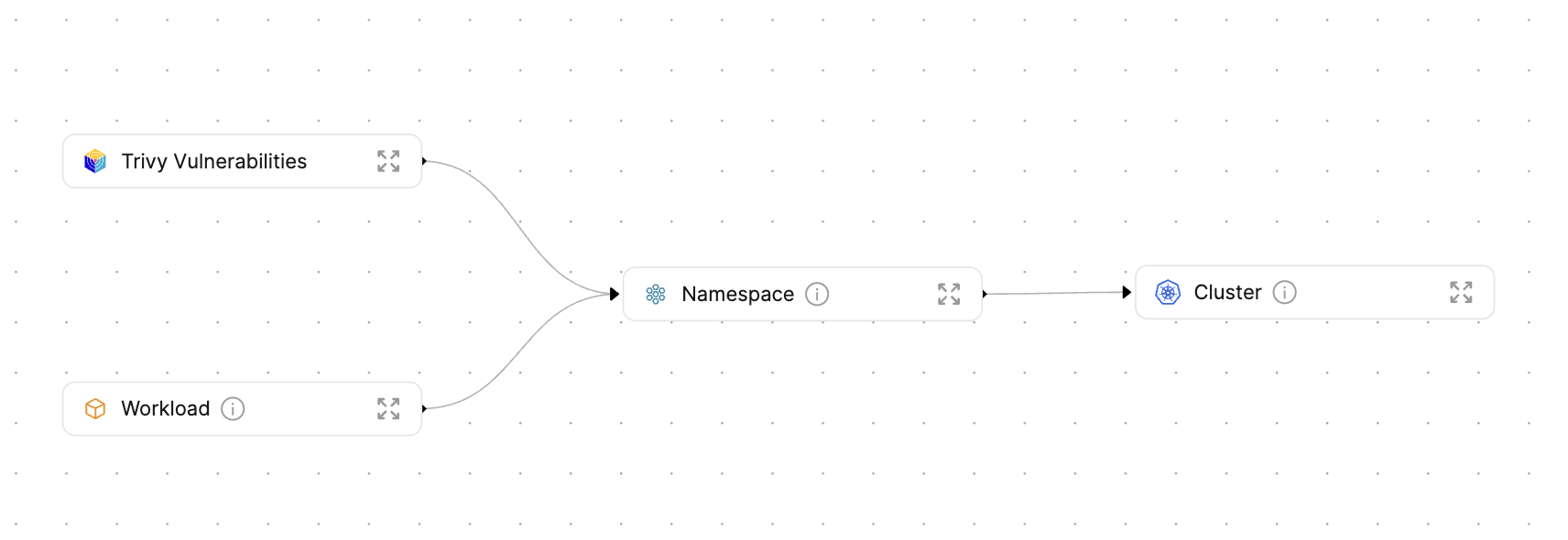Trivy Operator
Trivy Operator is an open-source security scanner that leverages Trivy to continuously scan your Kubernetes cluster for security issues.
Using Port's Kubernetes Exporter, you can keep track of all Trivy resources across your different clusters and export all the security and configuration issues to Port. You will use built in metadata from your kubernetes resources and CRDs to create entities in Port and keep track of their state.
Get to know the basics of our Kubernetes exporter here!

Prerequisites
- This guide assumes you have completed the visualize your services' k8s runtime guide
- Helm must be installed to use the chart. Please refer to Helm's documentation to get started
- The
jqcommand must installed - The
yqcommand must installed - The
kubectlcommand must be installed - Have your Port credentials ready.
In this use-case, you will use a custom bash script which will assist you in the process of installing Port's K8s exporter.
The script will install the helm chart to the Kubernetes cluster which is currently in kubectl context. To view the context name of the cluster the exporter will be installed on, run:
kubectl config current-context
Setting up blueprints & resource mapping
The following section will guide you through the process of setting up your blueprints and resource mapping using the installation script. You can read more about the installation script here.
Creating blueprints
The installation script provides a convenient way to create your blueprints. Using the CUSTOM_BP_PATH environment
variable, you can fetch a pre-defined blueprints.json to create your blueprints. For this use-case, you will
use this file to
define your blueprints. Do this by running:
export CUSTOM_BP_PATH="https://raw.githubusercontent.com/port-labs/template-assets/main/kubernetes/blueprints/trivy-blueprints.json"
This blueprints.json file defines the following blueprints:
- Cluster
- Namespace
- Workload
- Trivy Config Audit Report
- Trivy Vulnerability
-
Workloadis an abstraction of Kubernetes objects which create and manage pods. By creating this blueprint, you can avoid creating a dedicated blueprint per Workload type, all of which will likely look pretty similar. Here is the list of kubernetes objectsWorkloadwill represent:- Deployment
- StatefulSet
- DaemonSet
-
Trivy Config Audit Reportrepresents checks performed by Trivy against a Kubernetes object's configuration -
Trivy Vulnerabilityrepresents the latest vulnerabilities found in a container image of a given Kubernetes workload
Below are the Trivy blueprint schemas used in the exporter:
Trivy config audit report blueprint (click to expand)
{
"identifier": "trivyConfigAuditReport",
"title": "Trivy Config Audit Report",
"icon": "Trivy",
"schema": {
"properties": {
"category": {
"title": "Category",
"type": "string"
},
"messages": {
"title": "Messages",
"type": "array"
},
"description": {
"title": "Description",
"type": "string"
},
"severity": {
"title": "Severity",
"type": "string",
"enum": [
"LOW",
"MEDIUM",
"HIGH",
"CRITICAL",
"UNKNOWN"
],
"enumColors": {
"LOW": "green",
"MEDIUM": "yellow",
"HIGH": "red",
"CRITICAL": "red",
"UNKNOWN": "lightGray"
}
},
"remediation": {
"title": "Remediation",
"type": "string"
},
"success": {
"title": "Success",
"type": "boolean"
},
"scanner": {
"title": "Scanner",
"type": "string"
},
"scannerVersion": {
"title": "Scanner Version",
"type": "string"
},
"createdAt": {
"title": "Created At",
"type": "string",
"format": "date-time"
},
"updatedAt": {
"title": "Updated At",
"type": "string",
"format": "date-time"
}
},
"required": []
},
"mirrorProperties": {},
"calculationProperties": {},
"aggregationProperties": {},
"relations": {
"kubernetes_resource": {
"title": "Kubernetes Resource",
"target": "workload",
"required": false,
"many": false
}
}
}
Trivy vulnerability blueprint (click to expand)
{
"identifier": "trivyVulnerabilityReport",
"title": "Trivy Vulnerability",
"icon": "Trivy",
"schema": {
"properties": {
"resource": {
"title": "Resource",
"type": "string"
},
"score": {
"title": "Score",
"type": "number"
},
"fixedVersion": {
"title": "Fixed Version",
"type": "string"
},
"installedVersion": {
"title": "Installed Version",
"type": "string"
},
"lastModifiedDate": {
"title": "Last Modified Date",
"type": "string",
"format": "date-time"
},
"links": {
"icon": "DefaultProperty",
"title": "Links",
"type": "array",
"items": {
"type": "string",
"format": "url"
}
},
"primaryLink": {
"title": "Primary Link",
"type": "string",
"format": "url"
},
"publishedDate": {
"title": "Published Date",
"type": "string",
"format": "date-time"
},
"severity": {
"title": "Severity",
"type": "string",
"enum": [
"LOW",
"MEDIUM",
"HIGH",
"CRITICAL",
"UNKNOWN"
],
"enumColors": {
"LOW": "green",
"MEDIUM": "yellow",
"HIGH": "red",
"CRITICAL": "red",
"UNKNOWN": "lightGray"
}
},
"target": {
"title": "Target",
"type": "string"
},
"scanner": {
"title": "Scanner Name",
"type": "string"
},
"scannerVersion": {
"title": "Scanner Version",
"type": "string"
},
"createdAt": {
"title": "Created At",
"type": "string",
"format": "date-time"
}
},
"required": []
},
"mirrorProperties": {},
"calculationProperties": {},
"aggregationProperties": {},
"relations": {
"kubernetes_resource": {
"title": "Kubernetes Resource",
"target": "workload",
"required": false,
"many": false
}
}
}
Exporting custom resource mapping
Using the CONFIG_YAML_URL parameter, you can define a custom resource mapping to use when installing the exporter.
In this use-case you will be using the this configuration file. To achieve this, run:
export CONFIG_YAML_URL="https://raw.githubusercontent.com/port-labs/template-assets/main/kubernetes/templates/trivy-kubernetes_v1_config.yaml"
Below are the mappings for the Trivy resources:
Trivy config audit report mapping (click to expand)
- kind: aquasecurity.github.io/v1alpha1/configauditreports
selector:
query: 'true'
port:
itemsToParse: .report.checks
entity:
mappings:
- identifier: .metadata.name + "-" + .item.checkID + "-" + .metadata.namespace + "-" + env.CLUSTER_NAME
title: .item.title
icon: '"Trivy"'
blueprint: '"trivyConfigAuditReport"'
properties:
category: .item.category
messages: .item.messages
description: .item.description
severity: .item.severity
remediation: .item.remediation
success: .item.success
scanner: .report.scanner.name
scannerVersion: .report.scanner.version
createdAt: .metadata.creationTimestamp
updatedAt: .report.updateTimestamp
relations:
kubernetes_resource: (
if (.metadata.ownerReferences | length > 0) then
(.metadata.ownerReferences[] | select(.controller == true) |
.name + "-" + .kind + "-" + .metadata.namespace + "-" + env.CLUSTER_NAME
)
else
empty
end
)
Trivy vulnerability mapping (click to expand)
- kind: aquasecurity.github.io/v1alpha1/vulnerabilityreports
selector:
query: 'true'
port:
itemsToParse: .report.vulnerabilities
entity:
mappings:
- identifier: .metadata.name + "-" + .item.vulnerabilityID + "-" + .metadata.namespace + "-" + env.CLUSTER_NAME
title: .item.title
icon: '"Trivy"'
blueprint: '"trivyVulnerabilityReport"'
properties:
resource: .item.resource
score: .item.score
fixedVersion: .item.fixedVersion
installedVersion: .item.installedVersion
lastModifiedDate: .item.lastModifiedDate
links: .item.links
primaryLink: .item.primaryLink
publishedDate: .item.publishedDate
severity: .item.severity
target: .item.target
scanner: .report.scanner.name
scannerVersion: .report.scanner.version
createdAt: .metadata.creationTimestamp
relations:
kubernetes_resource: (
if (.metadata.ownerReferences | length > 0) then
(.metadata.ownerReferences[] | select(.controller == true) |
.name + "-" + .kind + "-" + .metadata.namespace + "-" + env.CLUSTER_NAME
)
else
empty
end
)
Alternative integration using GitHub file ingestion
While the Trivy Kubernetes exporter described above is the recommended installation method, you may prefer to use the GitHub file ingesting feature to ingest your Trivy scan results to Port.